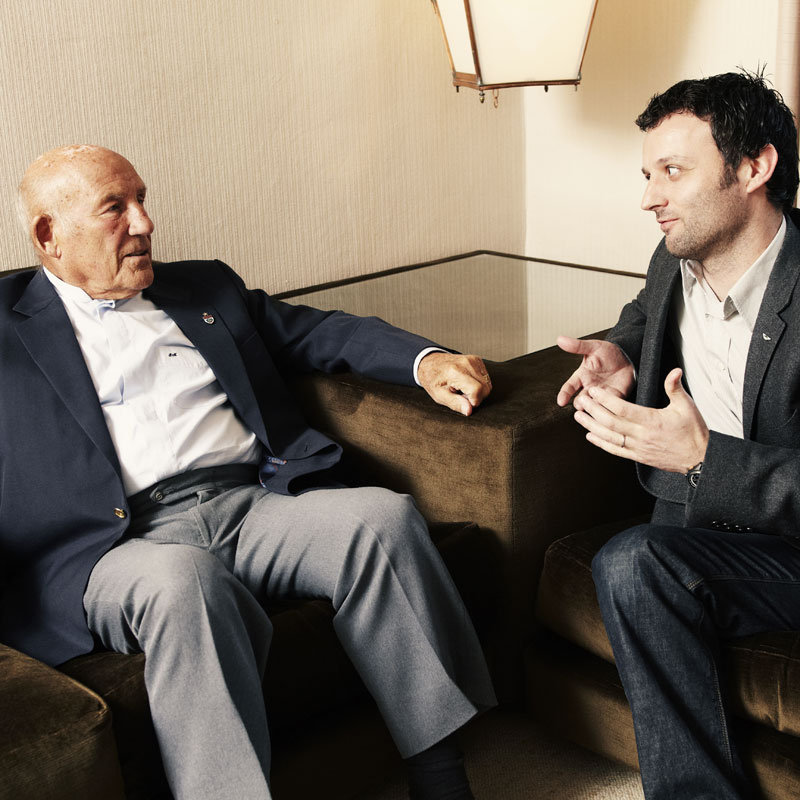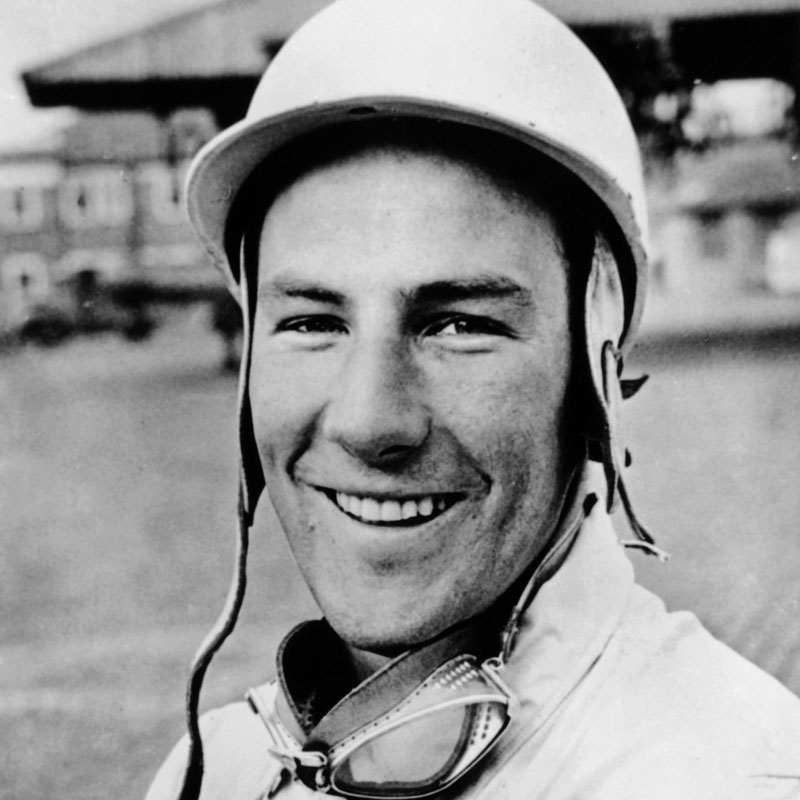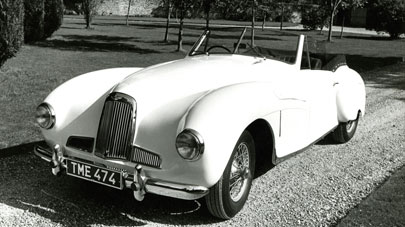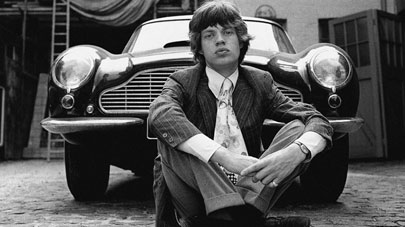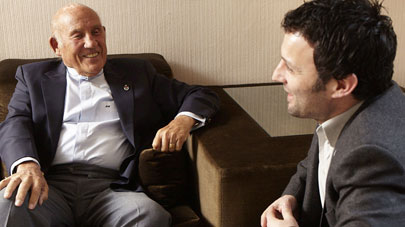Previous Article
Next Article
- AM WORLD
- 100 YEARS OF ASTON MARTIN
Centenary Sir Stirling Moss

Portraits by Jillian Edelstein
One of the great drivers to have sat behind the wheel of an Aston Martin, Sir Stirling Moss, tells current Works Driver Darren Turner about his favourite memories from his racing days and discusses how the sport has changed over the years
The name Sir Stirling Moss is synonymous with motor racing and the world of sports cars. Regarded by most observers as the best driver never to have won the Formula One World Championship, he nevertheless enjoyed a glittering career across a range of classes, winning races at iconic tracks such as Monaco, the Nürburgring, Goodwood and the Mille Miglia. His aggressive, no-holds-barred driving style meant that he was a favourite with the racing public around the world, while being known for exemplary sportsmanship throughout his career.
Darren Turner: How did you start out in racing? I know it was very different to today, where you have a set "ladder" which begins with karting, from which you work your way up through the Formulas.
Sir Stirling Moss: You’re right about that. Karts didn’t come in until the mid-1950s and I began in 1949, which is a shame in some ways because I think karting is terrific. My father had driven at Indianapolis and Brooklands, but he wanted me to be a dentist, not a racing driver. He eventually relented but insisted that I wear a crash hat. We just went straight into racing so you needed to be spotted by somebody who could give you the opportunity. A man called John Heath saw me driving and asked me to race for him at some races in Europe the following year in 1951. What you have to remember, as well, is that there was no racing in the United Kingdom at that time (post-Second World War) so we had to go abroad to race.
DT: What would you say was the main difference between racing in your day and now?
SM: It was certainly a lot more enjoyable in my day. Lewis Hamilton races and then straight afterwards he has to go and talk to Vodafone and their guests. When I finished my races, I used to go and chat up the ladies! I never had a sponsor during my racing career as the races weren’t televised so there was little incentive for companies to sponsor us. There would be a report after each race on the British Movietone News, which would show pictures, but that was it.
DT: So how did you afford to race?
SM: We were paid by the race organisers what was called "start money". They would invite drivers depending on their ability and their popularity, their box office appeal, so to speak. I quickly cottoned on to this and, as I finished a race, I would always wave to the crowd and so they would all wave back. The organisers would think: "This guy is very popular. We’d better invite him back next year." We also received money for oil from Shell or BP, and Dunlop gave us a discount on their tyres. First it was 50%, then 70%, and finally when I was established they gave them to me for free.
DT: Safety was presumably the other area that was very different. The precautions now have made driving racing cars a lot safer. Has it perhaps gone too far?
SM: Nowadays, unless another driver’s wheel comes off and hits you, it would be difficult to get killed while driving, such is the superb protection drivers get in the car. Aside from Ferrari, the cars in my era were bolted together from different parts so they weren’t particularly robust. You obviously can’t say "make it more dangerous" but I think you are right in many ways. The danger was one of the reasons I went into racing - no doubt about that. I can remember in the early 1950s, they found a material called Borax, which they put on the overalls to make them semi-fireproof but it was such a horrible material that we didn’t bother with it.
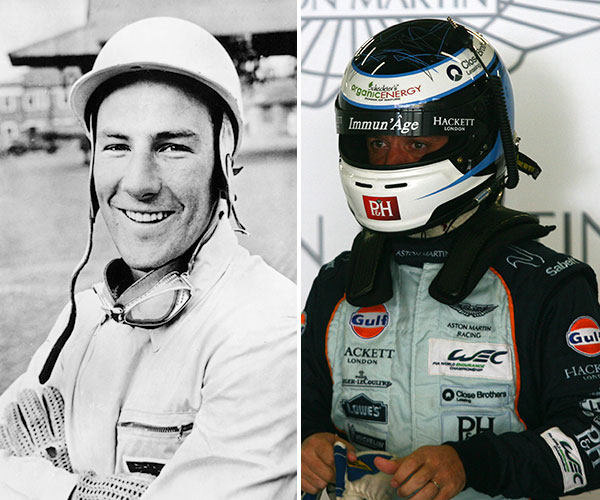
Sir Stirling in his white helmet, in the 1950s and Darren Turner in the contemporary Aston Martin Racing colours
DT: And you didn’t wear seatbelts did you?
SM: No, we didn’t. We didn’t have fire extinguishers either so you needed to get out of the car quickly in the event of a crash because they would normally catch fire. I saw somebody killed at Sebring once, when the car overturned at the hairpin and caught fire. He couldn’t get out as his arm was trapped. The circuits are also much safer as everything has been taken back from the track. My favourite tracks are places like Sebring and Dijon where you still feel close to the crowds.
DT: Does having everything sanitised detract from the experience and the spectacle in your opinion?
SM: In the UK, racetracks were all old, disused airports so the crowds were further back but elsewhere they would be right up close. I remember once, there was going to be a race around Hyde Park in London, which would have been fantastic but the police said that one million spectators would come along to watch and they refused to allow it to take place. But we would drive through the centre of Rome and other cities with people lining the streets.
DT: I imagine it was also somewhat different because you travelled around. No flying in and going straight from the airport to the racetrack, then back to the airport and home again.
SM: We drove from race to race, rather like a Grand Tour in some respects. The races were staged to make that possible so after driving at Monaco, for example, the team would pack up the cars in the lorries - well, most of them were converted buses - and Lance (Macklin) and I would drive off to the next track, which would be Bari in Italy or somewhere similar.
DT: You would drive in three or four classes on the same day. What was that like?
SM: I loved it as I just wanted to drive and to race. Often it would be five different formulae in one day: a race of champions, sports cars, Formula Two, Formula One and touring cars. I enjoyed the sports cars the most. All the different cars that you drove you tried to adapt them to suit your style. I liked a car that would go into a corner with slight oversteer, which you could power through, whereas with understeer you needed to back off.
DT: Your cars were more suited to oversteer, weren’t they? We use slicks these days, which prevent it. I drove a Cobra for the first time a couple of years ago and, as I sat down, I realised it was a very powerful car. Then I looked where my elbow was and saw there was nothing there. It brought home to me how little protection drivers had in your day - and the cars were definitely a lot rawer.
SM: The Cobra, now that’s a man’s car!
DT: I absolutely loved it and have since bought a touring car from the 1950s to drive as it’s such a great experience. With all those different classes, you must have driven a lot of races per year compared to the number we drive today. I probably drive about 16, which seems plenty.
SM: I would guess it was around 50 races a year on average. We would go over to Australasia or South Africa to drive in the winter rather than have a break. Nobody does that these days. They take themselves to the beach in the Caribbean for a holiday.
DT: Out of all the races in your career, which ones stand out in your memory?
SM: The Mille Miglia in 1955 was probably my favourite. It was 10 hours long and our main rival, Ferrari’s Piero Taruffi, knew the roads because he would drive them whenever he travelled back home to the south of Italy so he had a huge advantage. I would never have won it without my partner Jenks (Denis Jenkinson), though. He studied the route and would give me hand signals to show which way the corners and turns were and how sharp they were so I knew if I could take them flat out or not. We had just one stop during the 10 hours. That was in Rome and lasted exactly one minute and 40 seconds.
DT: What did you do for a comfort break?
SM: We came to the conclusion that it wasn’t really feasible. But when we got to Rome we hadn’t realised that they had put up grandstands for the crowds so we had to sprint round behind them and relieve ourselves, then run back to the car. We managed it in the minute and 40 seconds though.
DT: That was obviously road racing but you also raced on the most famous tracks around the world. Which were the most memorable?
SM: Le Mans was never a circuit that I particularly liked as the cars weren’t reliable enough in my day, so you had to nurse the cars round there rather than really go for it, which was my style. At Goodwood, I could really push the DBR1 to its limits but at Le Mans we had to restrict the revs as the car had reliability issues. Now, though, Le Mans is an incredible spectacle as you go flat out for 24 hours.
DT: You’re right about that - it’s a sprint from start to finish. The exception to that, of course, was in 1959 when you were driving for Aston Martin. You went out as a hare to lure Ferrari and set up the famous victory for Roy Salvadori and Carroll Shelby in the other Aston Martin DBR1, which is still the marque’s only outright victory in that race.
SM: Yes, they fitted my car with a special more powerful engine and John Wyer, who was a very good team manager I must say, just told me to go out and drive very fast, which was music to my ears, to see if we could tempt Ferrari into a high-speed duel. I was driving with Jack Fairman and the plan worked perfectly as Ferrari did exactly what we hoped. They tried to chase us down and burnt themselves out in doing so. Three of their cars were forced to retire with engine problems, which allowed the other two Aston Martins to finish first and second.
DT: You only ever drove as a pair. There must have been some long stints behind the wheel?
SM: You could have three or even four drivers but I always drove with just one teammate. We generally drove for three-hour spells, depending on fuel consumption and the weather. When you weren’t driving, you would try to get your head down and get some sleep, but with the noise from the cars and crowd you could never do anything more than doze.
DT: Which circuits did you really enjoy?
SM: The Nürburgring was the best circuit in the world in my opinion - no doubt about that. They have made it a lot smoother and wider these days, but it is still a great test of a driver’s ability.
DT: (Laughing) I’ve always considered it as one of the narrower tracks. It must have been very tight when you were racing there.
SM: It’s definitely a lot wider than it was. The DBR1 was a great car to drive around there, though, as it handled beautifully - you could really throw it around, which was how I wanted to drive. The brakes were great and the car had lovely balance. As we got to know the circuit, the engineers ironed out the flat spots and we were supremely competitive around the Nürburgring, which I suppose is why we won in both 1958 and 1959. It also looked very classy and I always preferred to drive a British car if I could. In fact, the first time I drove an Aston Martin, it was a DB2 in the Rally of Great Britain. I said to Lance: "Come on. Let’s go on a tour of the country and see if we can’t meet some nice women." Looking so stunning, it was the perfect car for a trip like that!
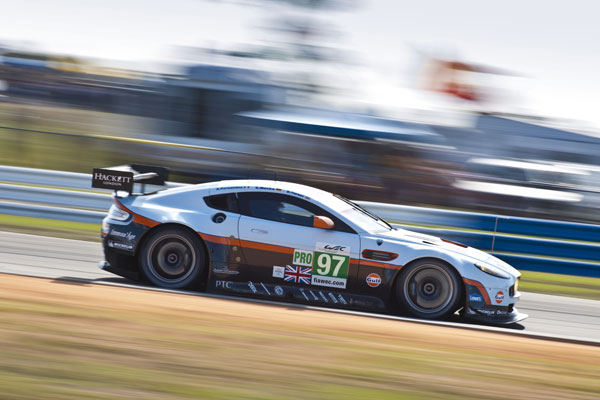
Turner piloting the modern Aston Martin Vantage GTE at Silverstone in last year’s World Endurance Car Championship
DT: You didn’t manage to win the Formula One World Championship, coming second on three occasions. In 1958 you were edged out by Mike Hawthorn after that famous piece of sportsmanship - your support meant he avoided a penalty in Portugal and he went on to beat you by just a point, despite winning one race compared to your four victories. Do you ever regret your actions?
SM: Absolutely not. It was the right thing to do. I don’t have any regrets about not winning the World Championship. The only regret I have from my career is not being able to drive a Ferrari in 1962. They had agreed to give me a 246 sports car, which I could drive in Roy Walker’s blue colours. They were supposed to give us all the parts but we would look after it and run it. But there was a delay in sending it over, which meant I had to drive the Lotus at the Goodwood Festival where I had my crash.
DT: To this day you can’t remember what happened?
SM: I can’t remember a thing. I was unconscious for three months and paralysed for six. I have a kind of amnesia and just can’t remember. The last thing that I can remember is talking to a very cute South African girl the night before the race. Three months later, I came round and wondered: "What are all these flowers doing here?"
DT: You have driven alongside and against some great drivers through the years. Who were the best?
SM: Tony Brooks, who drove for Aston Martin and for Vanwall, was the best racing driver that most people have never heard of. He was quicker than Juan Fangio in sports cars and was nearly as good in Formula One as he was in sports cars. Fangio was the best that I drove alongside in Formula One though.
DT: Which contemporary drivers do you rate?
SM: Sebastian Vettel is very quick and Fernando Alonso has done a tremendous job at Ferrari in the past couple of years. Michael Schumacher may have won all those titles, but in my mind that was mainly due to his car. He took a couple of very good English engineers over there and he was obviously a very good development driver as they built that unbeatable car, but Tony Brooks would wipe the floor with him in a head-to-head race in my opinion.
DT: And finally, do you think the period when you drove was a better period?
SM: It was miles more fun, no doubt about that. I wouldn’t have enjoyed driving today. There are too many commercial demands on the drivers.
CENTENARY
Previous Article
Next Article
- AM WORLD
- 100 YEARS OF ASTON MARTIN

